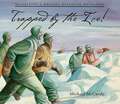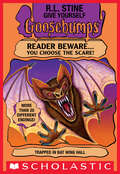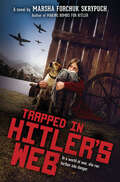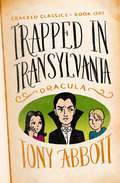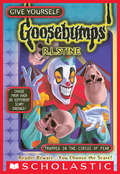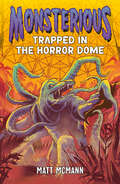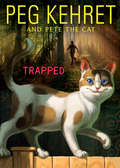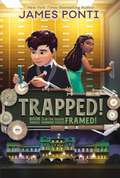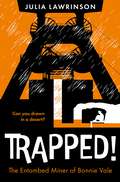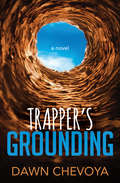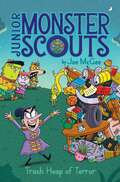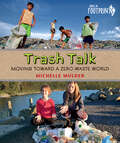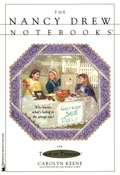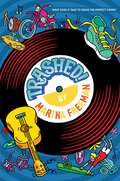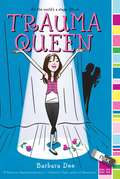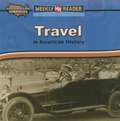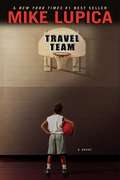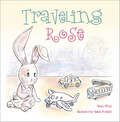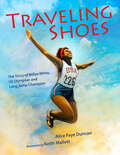- Table View
- List View
Trapped by the Ice! Shackleton's Amazing Antarctic Adventure: Shackleton's Amazing Antarctic Adventure
by Michael McCurdyDescribes the events of the 1914 Shackleton Antarctic expedition when, after being trapped in a frozen sea for nine months, the expedition ship, the Endurance, was finally crushed and Shackleton and his men made the very long and perilous journey across ice and stormy seas to reach inhabited land.
Trapped in Bat Wing Hall: Escape From The Carnival Of Horrors; Tick Tock You're Dead; Trapped In Bat Wing Hall; The Deadly Experiments Of Dr. Eeek (Give Yourself Goosebumps #3)
by R.L. StineChoose your fate on a wild scavenger hunt in this scary GOOSEBUMPS adventure that’s packed with more than twenty super-spooky endings.Being the new kid in school is no picnic. At your old school you had tons of friends, but now you don’t even have one. Then you meet Nick. He asks you to join Horror Club. The Horror Club meets in an old mansion known as Bat Wing Hall. It’s dark. It’s spooky. And it’s where your adventure begins. The members of the Horror Club are going on a scavenger hunt. If you join the red team, you find out the truth about your new friends—they’re actually monsters! One is a green-skinned reptile. Another is a hulking giant! If you join the blue team, you get turned into a furry-faced vampire bat! The choice is yours . . . Reader beware—you choose the scare! GIVE YOURSELF GOOSEBUMPS!
Trapped in Hitler's Web
by Marsha Forchuk SkrypuchIn the grip of World War II, Maria has realized that her Nazi-occupied Ukrainian town is no longer safe. Though she and her family might survive, her friend Nathan, who is Jewish, is in grave danger. So Maria and Nathan flee -- into the heart of Hitler's Reich in Austria.There, they hope to hide in plain sight by blending in with other foreign workers. But their plans are disrupted when they are separated, sent to work in different towns.With no way to communicate with Nathan, how can Maria keep him safe? And will they be able to escape Hitler's web of destruction?
Trapped in Transylvania: (Dracula) (Cracked Classics #1)
by Tony AbbottTwo reluctant readers and mischievous middle schoolers get transported into Bram Stoker&’s vampire classic in this &“lighthearted spoof&” (Publishers Weekly). Devin and Frankie—short for Francine—may be the best of friends, but they aren&’t the best of students. After they&’re busted for not reading Bram Stoker&’s Dracula, their teacher sends them to the library to make amends by mending books. When they accidentally toss an ancient copy of the horror classic through the library&’s broken metal detector, a huge crack opens in the wall—and sucks Devin and Frankie right into the novel itself. Now these sarcastic sixth graders will need a few stakes, a lot of garlic, and a sharp sense of humor to defeat the bloodthirsty count. In this first book in Tony Abbott&’s Cracked Classics series, &“Devin and Frankie are wisecracking underachievers and their characterizations and dialogue ring true. Abbott adroitly blends the language in Stoker&’s tale with their conversations, resulting in laugh-out-loud scenes&” (School Library Journal).
Trapped in Transylvania: (Dracula) (Cracked Classics #1)
by Tony AbbottTwo reluctant readers and mischievous middle schoolers get transported into Bram Stoker&’s vampire classic in this &“lighthearted spoof&” (Publishers Weekly). Devin and Frankie—short for Francine—may be the best of friends, but they aren&’t the best of students. After they&’re busted for not reading Bram Stoker&’s Dracula, their teacher sends them to the library to make amends by mending books. When they accidentally toss an ancient copy of the horror classic through the library&’s broken metal detector, a huge crack opens in the wall—and sucks Devin and Frankie right into the novel itself. Now these sarcastic sixth graders will need a few stakes, a lot of garlic, and a sharp sense of humor to defeat the bloodthirsty count. In this first book in Tony Abbott&’s Cracked Classics series, &“Devin and Frankie are wisecracking underachievers and their characterizations and dialogue ring true. Abbott adroitly blends the language in Stoker&’s tale with their conversations, resulting in laugh-out-loud scenes&” (School Library Journal).
Trapped in the Circus of Fear (Give Yourself Goosebumps, Special Edition #3)
by R. L. StineThe original series from the Master of Fright--now a major motion picture in theaters August 7, 2015!You did so well at Circus Camp, you're allowed to join a real circus for a week. But it turns out to be a Circus of Fear! Meet the Girl with Five Tongues and the Kid with Rotten Flesh. These sideshow freaks used to be normal kids-until the evil ringmistress got hold of them. And now she's after you. You'd better destroy her evil powers-before she turns you into the Kid Who Lives in a Jar! The choice is yours in this scary GOOSEBUMPS adventure that's packed with over 20 super-spooky endings!
Trapped in the Horror Dome (Monsterious #5)
by Matt McMannThis series of terrifying standalone tales that combine monsters + mysteries is perfect for fans of Goosebumps.&“Spine-chilling and creepy!&” —Max Brallier, #1 New York Times bestselling author of The Last Kids on Earth, on Escape From Grimstone Manor (Monsterious, Book 1)When their school wins a state science competition, Rowan, Tinker, and Amari earn a dream trip to Earth Two, a biodome research lab deep in the desert, which is sealed off from the outside world. What could be cooler?But soon, strange things begin to happen. In the dome&’s swamp ecosystem, the kids discover a creature unknown to science—though the adults don&’t believe them. Then a scientist is mysteriously attacked and Earth Two&’s security and life-support systems fail, trapping everyone inside.As oxygen runs low, a terrifying monster emerges from the shadows and begins to hunt. Now the kids must find a way to escape . . . before the biodome becomes their tomb.
Trapped! (Pete The Cat)
by Peg KehretA new Pete the Cat mystery in paperback for the first time! Alex and his friends witness a pig falling from a speeding red truck. Working with the police and an animal rescue group, the kids get permission to keep the pig. But after a local TV station runs a story about the rescue, the angry truck driver shows up at Alex?s house, determined to take the pig to slaughter. Who is this man? What is he hiding? Pete uses his skills to solve the mystery but, as usual, his humans don?t understand. When the dangerous situation turns deadly, can Pete save himself?
Trapped!: Framed!; Vanished!; Trapped! (Framed! #3)
by James PontiFlorian Bates—the only kid on the FBI Director’s speed dial and several international criminals’ most wanted lists—must save his friend from being framed for a crime he didn’t commit in this hilarious third novel in the Framed! series.Middle school is hard. Solving cases for the FBI is even harder. Doing both at the same time, well that’s just crazy. But that doesn’t stop Florian Bates! Along with his best friend, and Watson to his Sherlock, Margaret, Florian’s making the case that kids can do anything. When Florian and Margaret’s FBI supervisor, Marcus Rivers, is accused of a crime, it’s up to this mystery solving duo to jump into action and clear his name, because Marcus is more than their boss—he’s family. The case involves one of Marcus’s first investigations for the FBI and a Russian spy ring. However, when the spy they are chasing learns what they’re up to, the tables are turned, and Marcus finds himself implicated in a variety of crimes, including theft, corruption, and espionage. For Florian and Margaret, it just got personal. They’re going to catch the spy and clear Marcus’s name…even if they have to break into (and out of) the Library of Congress to do it.
Trapped: The emtombed miner of Bonnie Vale
by Julia LawrinsonIn 1907, the mining town of Bonnie Vale experiences a sudden deluge of rain that floods a gold mine while miners are still at work down the shaft. Joe's dad is one of them. And it soon becomes clear that he's the only one who hasn't made it back out. Where is he? Why didn't he escape with the others? And more importantly, how will they rescue him?
Trapper's Grounding: A Novel
by Dawn ChevoyaA fantastical tale of a boy who finds something amazing in the forest—and then finds the courage to stop hiding . . . At school, Brennon Trapper does whatever he must do to be liked, but at home inside his trailer, he crawls back inside himself, wishing he could disappear. His father likely wouldn&’t even notice if he did. Then, something too incredible to believe happens on his family&’s wooded property, and Brennon and his younger brother vow to keep it from their parents rather than risk ridicule again. Seriously, who would believe that a beaver gave them a tesserapod that could develop into a lodge of sorts in two hundred days if grounded correctly? But when an epic blizzard destroys the roof of their trailer, Brennon finally comes clean about the woods and what he thinks may be a place of shelter.
Trash Heap of Terror (Junior Monster Scouts #5)
by Joe McGeeThe Junior Monster Scouts take out the trash when a new villain comes to town in the hilarious fifth chapter book of the Junior Monster Scouts series!The Junior Monster Scouts have a new grump in town to contend with: Baroness Von Grumpier! A cousin of Baron Von Grump, she&’s even grumpier, and even more diabolical! And her sidekick is a toad…a very warty, always frowning, not-ever-happy toad. Baroness Von Grumpier has come to visit while her cousin goes on vacation. She wants to tidy up his windmill, but when she takes out all of his garbage and dumps in into one big, stinking trash heap, it comes alive! Can the little monsters save the townspeople from the ruthless rubbish?
Trash Mountain
by Jane YolenThis you should know: Gray squirrels are almost always larger, faster, and more aggressive than reds. They out-eat the reds and out-breed them. Science says the grays will eventually win. Nutley is a young red squirrel. For most of his life, he's been content to live on local seeds and the cautious wisdom of his parents. But like so many young squirrels before him, he feels the call of the wild (and the hazelnuts) beyond the safety of his family's own tree. Nutley wonders what it would be like to be Dangerous, like the growing band of gray squirrels that roam his neighborhood. Nature, which is truly red in tooth and claw, forces Nutley to find out if he's cut out for a life of danger. He must flee his familiar tree for the smelly shelter of the local landfill. There, with the help of some unlikely allies, he might just be able to make a stand against the grays. This you should know: No matter what scientists say is almost always true, the exceptions are almost always the best stories.
Trash Talk: Moving Toward a Zero-Waste World (Orca Footprints #6)
by Michelle MulderHumans have always generated garbage, whether it's a chewed-on bone or a broken cell phone. Our landfills are overflowing, but with some creative thinking, stuff we once threw away can become a collection of valuable resources just waiting to be harvested. Trash Talk digs deep into the history of garbage, from Minoan trash pits to the Great Pacific Garbage Patch, and uncovers some of the many innovative ways people all over the world are dealing with waste.
Trash or Treasure? (The Nancy Drew Notebooks #34)
by Carolyn KeeneSometimes one person's trash is another person's treasureThe sign says No Early Birds, but everyone's already lining up for the neighborhood garage sale. Nancy and her friends are helping out. Each has already spotted something she wants, and they're all happy except Bess. She loves a beautiful ballerina painting, but it's too expensive -- and at least three other people are interested in it.Bess can't afford the ballerina unless she sells some of her old CDs -- fast! The girls are trying to help her when the painting suddenly disappears. Who took it? Was it a real treasure worth a fortune? Nancy has already lined up some big-name suspects. If she doesn't solve this one, her detective career will be trashed!
Trashed!
by Martha FreemanFrom Edgar Award–nominated author Martha Freeman comes a compelling middle grade mystery following a young boy working at his family&’s secondhand store that is a steal-your-heart story about family and friendship.Arthur Popper helps out in his family&’s Boulder, Colorado, junk store, Universal Trash, a place so full of cool stuff it inspires awe in first-time shoppers. When it comes to ukuleles, peppermills, and rhinestones, Arthur knows what&’s what. But unlike his motorcycle-riding grandma and his namesake, King Arthur, he&’s not brave or adventurous. Then Arthur finds a chipped teacup, of all things, and realizes it&’s the key to solving the perfect crime—a crime only he knows about. With help from a supernatural sidekick, his best friend, his annoying little sister, and a sad-faced police officer, Arthur embarks on the hard work of detecting. Everyone knows Arthur is good at customer service. Does he have what it takes to solve a mystery and confront a thief?
Trauma Queen
by Barbara DeeEvery tween girl knows what it's like to have a mom who can be a little embarrasing at times. But for Marigold, it goes way beyond embarrassing. Marigold's single mom is a performance artist, meaning she stages dramatic, wacky performances to express her personal beliefs. Things like wrapping herself in saran wrap for a piece on plastic surgery, or inviting people over in the middle of the night to videotape her sleeping. In fact, Marigold's mom's performances caused such a ruckus in their last town that the two of them, along with Marigold's little sister, have just had to move. Now Marigold's starting a new school, missing her best friend like crazy, and trying to fit in all over again in the shadow of a mom who's famous for all the wrong reasons. As if that's not bad enough, Marigold's mom takes on a new job--teaching drama at Marigold's school! Now all the kids know instantly just how weird her mom is, and Marigold's worried she'll never be able to have a friendship that can survive her mother.
Travel In American History (How People Lived In America)
by Dana Meachen RauAn account of the ways people travel-- from the earliest means to the most recent.
Travel Team
by Mike LupicaDanny Walker may be the smallest kid on the basketball court, but no one has a bigger love of the game. Then the local travel team-that Danny's dad led to the national championship when he was a kid-cuts Danny because of his size. It turns out that he's not the only kid who was cut for the wrong reasons. Now Danny and his dad are about to give all the castoffs a second chance and prove that you can't measure heart.
Traveling Rose
by Brian WrayAward-winning author-and-illustrator team Brian Wray and Shiloh Penfield are back with a new adventure featuring their beloved children's book character, Rose the stuffed bunny. In Traveling Rose, she is taking her very first big trip to London with her friend Iris and her favorite little boy. Rose is excited about the teas they would have, but soon becomes distracted by her worries. Did she pack her favorite sweater in case the weather is cold? Did she remember to turn off the lamp by her bedside? Her thoughts feel so big that Rose begins to cry and no longer wants to go. Can Rose find a way to let her worries at home and have fun on her trip? The story offers a great way for parents and teachers to talk to children about what happens when impulsive and obsessive thoughts get in the way of enjoying life's big moments as well as everyday life, and what to do about it. These types of “first times” can be stressful for anyone but, for someone with intrusive thoughts, can be filled with obstacles. Intrusive worries are there at every turn, pointing out all of the things that could go wrong or that are “dangerous.” It takes work to see through the fears and picture the possibilities, especially for our beloved Rose Bunny. Children will identify with Rose, and by allowing children to see themselves in a story, it shows them that they are not alone in their experience. Ideal for social and emotional learning, Traveling Rose teaches children to express emotion, which is one of the key ingredients to healthful development. Rose continues to be a starting point to having larger conversations that will create a lasting impact. Don’t miss her in her first picture book, Unraveling Rose.
Traveling Shoes: The Story of Willye White, US Olympian and Long Jump Champion
by Alice Faye DuncanUntold until now, here is the story of Black sprinter and long-jumper Willye B. White, who went from picking cotton as a child in Mississippi to competing and winning in the 1956 and 1964 Olympics.Future Olympian Willye B. White was born in 1939 in Money, Mississippi—but money was exactly what she didn&’t have. Abandoned by both her parents, she worked alongside her grandparents in the cotton fields. Willye had big dreams, though. So when her cousin noticed she was the fastest runner around, Willye jumped at the chance to put on her traveling shoes and run her way to better opportunities. And run Willye did, first for the Tennessee State Tigerbelles and then for the US Olympic team. Her struggles weren&’t over though—time and again, Willye had to remind herself, &“I believe in me,&” whether she was running and jumping or witnessing the turmoil of the Civil Rights Movement.Through Alice Faye Duncan&’s signature combination of poetry and prose and Keith Mallett's lifelike illustrations, readers will be inspired by Willye White&’s persistence and will learn how she contributed to Black progress with muscle and grit.
